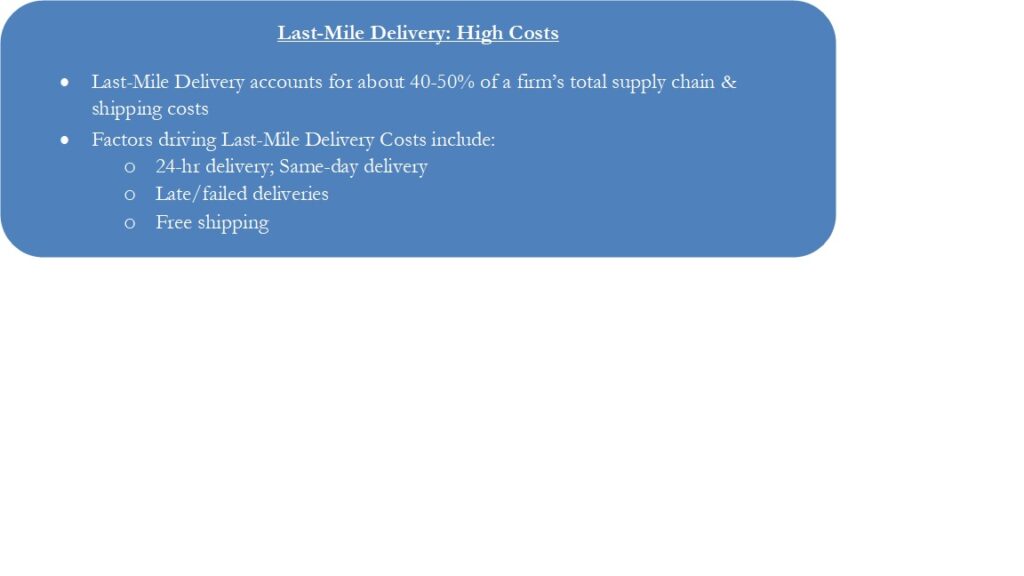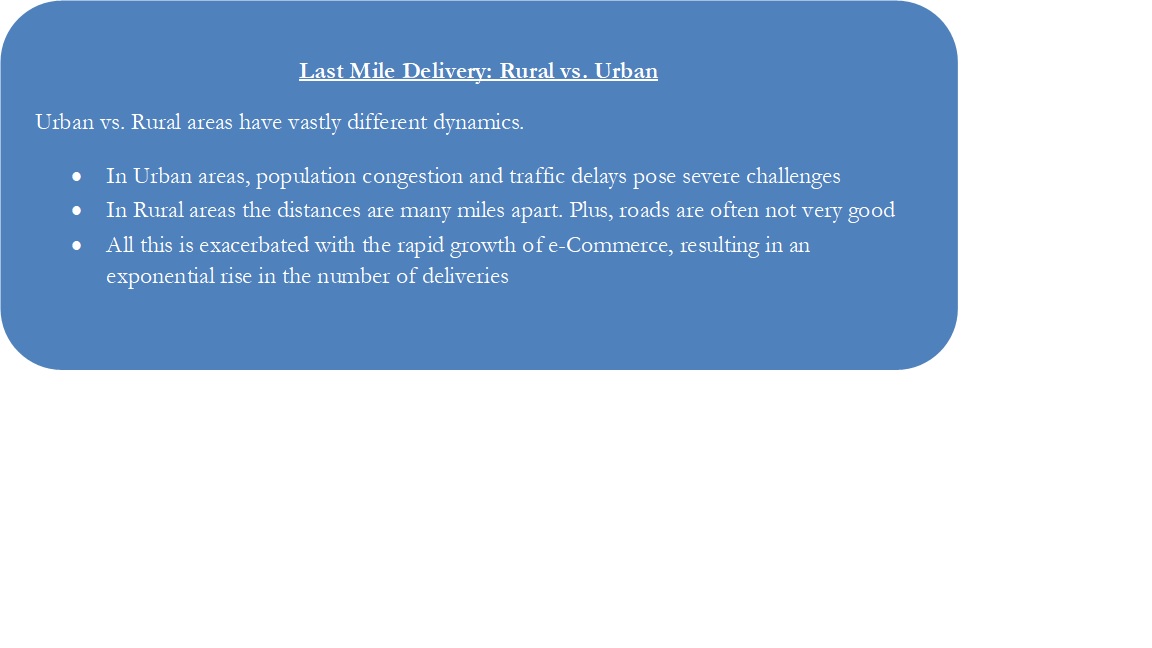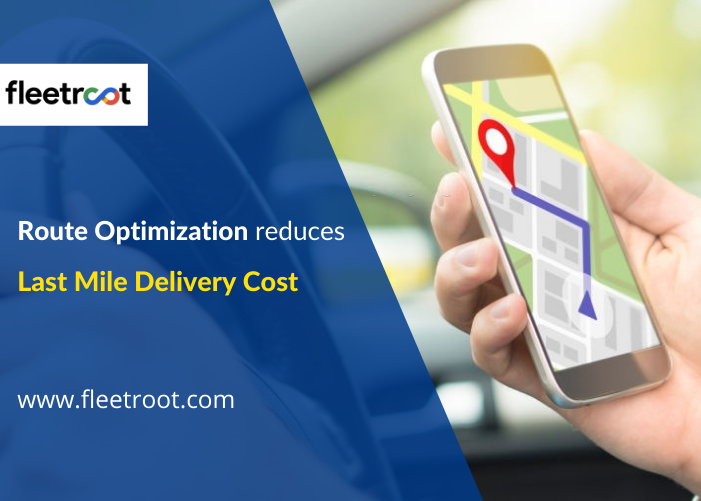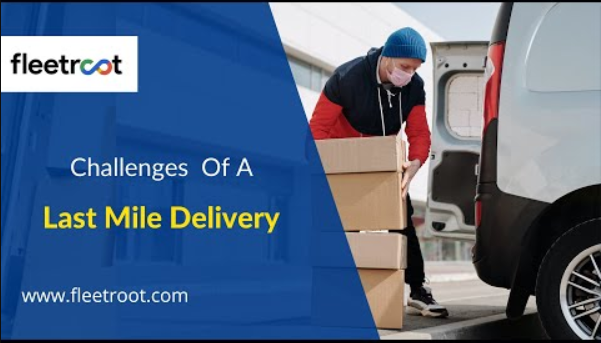Summary
Last-Mile Delivery costs often constitute up to 50% of a firm’s logistics and distribution cost. While it may only, literally, form the “last mile” of a complex supply chain network it is the most challenging and complex part to manage.
Additionally, with consumer demands becoming more stringent by the day – fuelled by “Same-day” and “24-hr” delivery models heralded by eCommerce giants like Amazon – the delivery options offered by firms have become an all-important tool in driving customer satisfaction.
Using a modern, automated Route Optimization Software enables Fleet Managers to manage the complex elements that constitute Last-Mile Delivery costs.
What is “Last-Mile Delivery” cost?
Last-Mile Delivery cost is the investment (employees, vehicles, systems, warehouses, etc.) that companies make into planning and executing the final step of delivering goods to their customers. It literally is the “last mile” traveled by the parcel before finally being delivered to its end customer.
Why has Last-Mile Delivery cost gone up in recent years?
Rapidly changing consumer behavior across the world – fuelled by the rapid growth of eCommerce and its 24-hr delivery models – has made today’s consumers far more demanding. Nowadays, the delivery options and fulfillment performance of firms has become a critical element in the battle to win customers, drive customer satisfaction, ensure repeat purchases, and build company loyalty.
Managing cost while maintaining delivery efficiency poses the biggest challenge in managing Last-Mile Delivery effectively. Mishandling will result in financial losses, negatively affect company reputation, and lead to poor customer experience.

Route Optimization Software can be used to control several critical elements that contribute to Last-Mile Delivery costs.
1. Route Optimization: The method of identifying the most effective route between two points while ensuring the maximum number of deliveries is called “Route Optimization”. Logistics firms need to consider numerous variables including customer delivery windows, availability of drivers and vehicles, type of cargo, weather, and traffic patterns (etc.), to come up with the most effective route. Remember, the most effective route isn’t the shortest or the cheapest, but the one that balances out all factors that impact daily delivery schedules.
The challenge goes deeper since all factors are dynamic and constantly changing. Examples include driver idle-time, one-way routes, highways vs. non-highways, driving habits, fuel consumption, and accidents. A Route Optimization Software uses dynamic route optimization methods while taking into account all variables and their fickleness – therefore, it can integrate new orders, transfer deliveries between drivers/vehicles automatically, re-route in real-time while maintaining cost-effectiveness and efficiency.
2. Maintaining delivery visibility: One of the most important benefits of Route Optimization Software is that Fleet Managers have complete visibility of their logistics and distribution process i.e. there is 100% transparency in real-time. This enables Fleet Managers to not only monitor all their cargo and vehicular movements but also solve problems and emergencies immediately. Through constant communication between the delivery teams, on-ground staff, and control room teams, Fleet Managers can track the progress of their parcels (and, delays if any).
3. Real-Time tracking: By extension of the point above, the transparency and visibility that Route Optimization Software offers, enables Fleet Managers to communicate constantly with all stakeholders in real-time, and therefore, track the progress of a shipment in real-time. For example, delays caused by traffic congestion or inclement weather can be tracked – and, solved – in real-time while keeping customers updated about the changes via notifications or SMS.
4. Maintaining Customer Satisfaction: The advent of e-Commerce with its “24-hr delivery” and “Same-day delivery” has been responsible for changing customer expectations significantly. These delivery options – unimaginable till even a decade or so ago! – are now increasingly the norm. Customers not only want to be kept updated about their delivery times but also want to be allowed to choose their delivery windows and even change it per their convenience, if needed. Given that this is now the “new normal” for the delivery business, Logistics and Delivery firms of all types have to keep up because if they don’t, they risk losing their customers to competition that surely is.
Ultimately, customer satisfaction is the goal of any business.

5. e-POD (Electronic Proof of Delivery): Modern automated software allows delivery companies to capture proof-of-delivery through e-signatures, pictures, or notes and immediately upload this into the central system. This not only resolves traditional issues of unnecessary paperwork but also prevents lost/ damaged delivery notes, reduces physical storage space required, and prevents malpractices.
6. Data Analytics: Perhaps, the most important benefit in using a modern Route Optimization Software is its ability to mine the vast amounts of real-time data that is constantly generated and captured across all aspects of the delivery operation. Detailed analysis of such data enables Fleet Managers in identifying shortfalls and inefficiencies across the entire supply chain, especially across last mile delivery.
Data such as the average time needed per delivery, planned vs. actual, fuel consumption, driver habits, accident records, safety protocols (etc.) is easily accessed at various levels (individual drivers, clusters, teams) across any time period (hourly, weekly, monthly). This analysis generates invaluable insight based on factual data and allows Fleet Managers to tackle issues such as:
- Accident-prone times and routes
- Typical traffic and weather patterns (can be tracked across a 12-month period)
- Malpractices e.g. pilferage, drivers using company vehicles to run a private delivery business on the side
- Driver performance: underperforming drivers, all-star performers, learnings from each set
7. Optimize efficiency, minimize costs: As described above, the usage of Route Optimization Software enables the use of modern technology in analyzing and controlling every single aspect of a delivery operation right from planning to execution through till review. At an overarching level, this enables transportation companies to minimize costs, maximize efficiency, and optimize limited resources to achieve a profitable operation.
Conclusion: Using last mile delivery management software to control costs and optimize routes is imperative for firms to maintain an efficient distribution operation, drive customer satisfaction, and maintain profitability.




